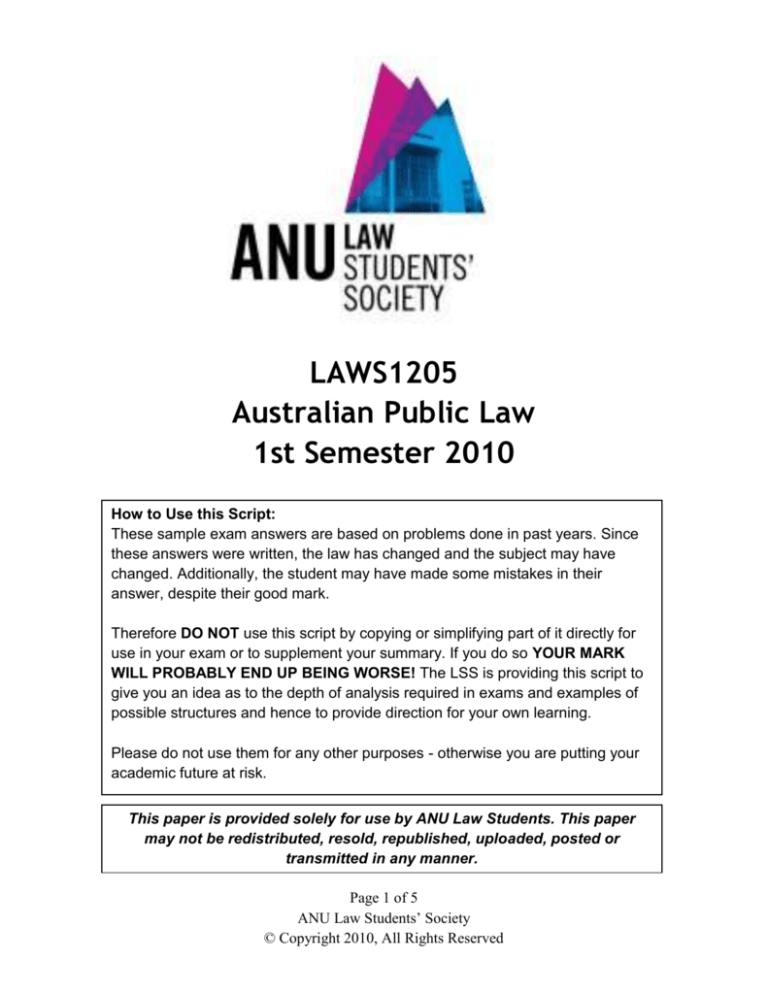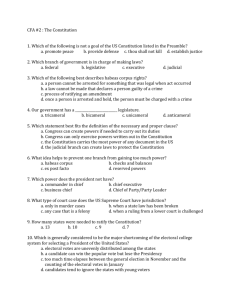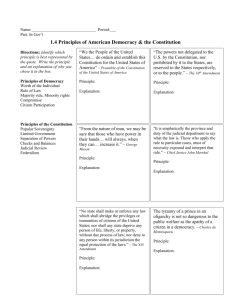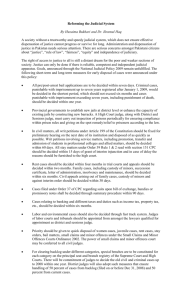
LAWS1205
Australian Public Law
1st Semester 2010
How to Use this Script:
These sample exam answers are based on problems done in past years. Since
these answers were written, the law has changed and the subject may have
changed. Additionally, the student may have made some mistakes in their
answer, despite their good mark.
Therefore DO NOT use this script by copying or simplifying part of it directly for
use in your exam or to supplement your summary. If you do so YOUR MARK
WILL PROBABLY END UP BEING WORSE! The LSS is providing this script to
give you an idea as to the depth of analysis required in exams and examples of
possible structures and hence to provide direction for your own learning.
Please do not use them for any other purposes - otherwise you are putting your
academic future at risk.
This paper is provided solely for use by ANU Law Students. This paper
may not be redistributed, resold, republished, uploaded, posted or
transmitted in any manner.
Page 1 of 5
ANU Law Students’ Society
© Copyright 2010, All Rights Reserved
Part B Question 4 (Essay)
Mark: 80%
The doctrine of the separation of powers is one extending back hundreds of years. It is a doctrine, which
has had a significant impact on the Australian constitutional system, and is consequently reflected within
it. However, this essay argues that the doctrine has, to a degree, been tempered by the recognition of
responsible government, despite its obvious reflection in the Cth Constitution. This essay will also discuss
the separation of judicial power principles as part of the overall doctrine, and the significant impact it has
on limiting and regulation the role of the judiciary. The issues of an elected judiciary and of parliamentary
privilege will also be discussed. The doctrine of the separation of powers is reflected in the Australian
constitution law systems to a significant degree. This essay will focus on the Cth Constitutional system
primarily, as this is where the operation of the doctrine is very clear.
As stated, this doctrine is hundreds of years old. In the 1700s Montesquieu suggested that √
political liberty can only be found where there is no abuse of power, and that to prevent such abuses there
must be checks on power. He identified three sorts of power in government: legislative, executive and
judicial. He suggested that their separation was necessary because where powers are united in the same
body there can be no liberty. Taking a more modern view in 1987, Phillips and Jackson recognised that in
modern times the function of the executive has widened considerably. They suggested, as a deviation
from Montesquieu’s stricter approach, that, “A complete separation of powers…with no overlapping or
co-ordination would (even if theoretically possible) bring government to a standstill”. They suggest that
the doctrines role is to prevent tyranny and to enable checks on power.
The more modern view of Phillips and Jackson can be seen reflected in the Commonwealth Constitution
today (even though it was enacted in 1900). The Constitution most obviously reflects the doctrine through
Chapters I, II and III, which provide separately for the ‘Legislature’, ‘Executive’ and ‘Judiciary’
respectively. S 1 states that Cth legislative power is vested in Federal Parliament, consisting of the Queen,
a Senate and a House of Representatives. S 61 (of Chapter II) vests executive power in the Queen, as
exercisable by the Governor General. S 71 vests judicial power in the HCA and other federal courts the
Parliament creates. Apart from the Queen being in both the executive and legislature, ss 1, 61 and 71
clearly reflect the doctrine. √
Page 2 of 5
ANU Law Students’ Society
© Copyright 2010, All Rights Reserved
However, particularly in relation to ss 1 and 61, the Constitution is not reflective of constitutional reality.
It has been seen since at least 1975 (during the Constitutional crisis) that the Queen does not interfere
with Australia’s constitutional affairs. Furthermore, by convention the Governor-General (in relation to s
61) acts only on the advice of the Prime Minister and Cabinet, although these two bodies exists only by
very well-established constitutional conventions. Furthermore, as part of a system of responsible
government, ministers answer to parliament (the legislature) for their actions, not to the GovernorGeneral. This creates some cross-over where the legislature and executive are both found within the same
institutions. This is a deviation from the strict separation of powers Montesquieu championed. √
The operation of the doctrine in Australia is closely tied with the idea of parliamentary sovereignty, which
arguably helps to improve or strengthen the separation of powers within Australia. P/mentary supremacy
is the pre-eminent principle of English public law, and part of England’s constitutional legacy to
Australia. In 1885 Dicey suggested that it means parliament can make or unmake any laws, and that
‘judicial legislation is…subordinate legislation’. This is reflected in Australia. Where a judicial decision
is inconsistent with legislation the legislation will prevail to the extent of the inconsistency. However, this
does not give parliament absolute power. As Jennings highlights, the legislature’s powers are derived
from the law, namely the Constitution. S 76(i) of the Constitution gives the High Court additional original
jurisdiction where parliament makes law conferring on it power about the constitution and its
interpretation. The judiciary’s power to declare any Cth legislation (or state) constitutionally invalid
demonstrates how the separation of powers in Australia prevents any abuse of that power by the
legislature. The situation in Australia is not as Dicey described in 1995. Rather, the courts can check even
on Cth legislation. √
However, the judiciary’s power is also restricted in this regard. At Cth level there exists separation of
federal judicial power principles, which prevent the judiciary from intervening about legislation before a
dispute is brought before a court enabling them to do so, thus being reactive only. These principles state
that only courts listed in s 71 of the Constitution can exercise federal judicial power, and those courts can
only exercise judicial power, and non-judicial power incidental to the exercise of judicial power
(Alexander’s Case; Boilermakers). √ There are a number of consequences arising from the establishment
of these principles (which apply only at a federal level). Firstly, it becomes necessary to define judicial
power, to determine when it is being exercised. This is not an easy task, but several indicia emerge from
case law (see, e.g., Tasmanian Breweries). These indicia include the conclusiveness, bindingness, and
enforceability of the decisions). They also require a determination of controversy over existing rights
Page 3 of 5
ANU Law Students’ Society
© Copyright 2010, All Rights Reserved
according to judicial process and by the application of ascertainable legal standards and criteria. Thus, as
is seen in Thomas v Mowbray, and Bass v Permanent, judicial power is restricted in its operation to times
when cases and disputes are brought before the court. To determine existing rights, the disputes are
necessarily about existing law the legislature has passed. In this way, the judicial branch of government is
limited by being responsive only to cases. Conversely, the legislature can pass laws at any time (within its
restrictions). √
The second consequence emerging from these principles is that federal judicial bodies cannot give
advisory opinions or exercise administrative discretion. Thus, neither federal courts nor judges can pass
judgement about proposed bills, or laws in parliament until there is a dispute. This clearly shows the
operation of the separation of powers reflected in the Australian federal Constitutional system. While
there are exceptions to the separation of federal judicial power principles they are restricted. For example,
the persona designata exception regarding federal court judges only enables judges to exercise nonjudicial power where they are acting in their personal capacity (Drake), and consent, and where the
function is not incompatible with their judicial function (Grollo). Grollo identified that such
incompatibility could arise where the integrity of either the judge or the judiciary generally would be
compromised by the performance of the non-judicial function. Thus, this prevents judges from
undermining the separation of powers by influencing the development of Australian law at times other
than those anticipated by the Constitution itself. Where a judge does act persona designata, they do so
independently of the judiciary. √
At State level this judicial separation of powers is not entrenched so it is less clear. However, a number of
cases including Kable and International Finance indicate that “institutional integrity” is the leading
criterion regulating the way State parliaments can deal with their courts.
The issue of an appointed judiciary is raised by some legal commentators as being a factor undermining
the independence of the judiciary, and thus the separation of powers in Australia. Indeed, judges are
appointed to their positions in Australia unlike in countries like the United States where they are elected
by popular vote. Essentially, this means the seven individuals forming the High Court of Australia, whose
decisions are binding upon all Australia and change only by the Court, are chosen by the Executive.
Consequently, this raises questions about the other arms of government appointing judges whom they
believe will politically be more in line with their thinking, and thus less likely to make decisions against
their favour.
Page 4 of 5
ANU Law Students’ Society
© Copyright 2010, All Rights Reserved
This is a genuine concern. However, the power of public opinion is not to be understated. Indeed the
Constitution itself, via the operation of s 128, recognises that popular sovereignty, continues to operate in
Australia. If the public were continually dissatisfied with the judgements of Australian courts the
judiciary would lose both its validity and judges, their integrity. The judiciary has always made decisions
that invalidate legislation of the current government, and many decisions of the High Court are very close,
indicating that there is a diversity of viewpoints on the bench. Thus, while the appointment of the
judiciary is an issue theoretically, in practice is has not proven to be a real threat undermining or watering
down the continuing operation of the separation of powers. √
The idea of parliamentary privilege is another more minor area in which the operation of the doctrine can
be seen. In R v Richards the High Court recognised that s 49 of the Constitution is incapable of limited
operation and that, at least in relation to the privilege regarding parliamentary contempt, parliament
retains this privilege of the House of Commons. As seen in Egan v Willis and Egan v Chadwick courts
will not interfere with the legislatures exercise of this privileges (except in Willis where the issue was
rendered justiciable only by reason of being triable with a trespass charge). The separation of powers is
thus, evident in relation to privileges. The judiciary does not intervene in what is considered to be a nonjusticiable issue now.
√
In conclusion it can be seen that the separation of powers principles are reflected in the Australian
constitutional law systems to a substantial degree. Whether in relation to the federal separation of judicial
power principles or to the doctrines reflection in the Cth constitution, the doctrine continues to play a
significant role in the checking of judicial, executive and legislative power in Australia, most notably at
the Cth level.
This is a nicely constructed paper that draws on material covered in the course. Well done.
80
Page 5 of 5
ANU Law Students’ Society
© Copyright 2010, All Rights Reserved










